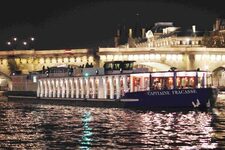Quai Branly Museum: History, Information and Access

Located in the heart of the 7th arrondissement, right at the foot of the Eiffel Tower, the Quai Branly Museum - or the museum of arts and civilizations of Africa, Asia, Oceania, and the Americas - was inaugurated in 2006. With around 125,000 visitors per month, the ambitious project of this museum was to honor "primitive arts" (traditional African art, Inuit art, Oceanic art, traditional Native American art…) by dedicating a new specific space to them.
The origins of the Quai Branly Museum
Passionate about "primitive arts" - the traditional artistic creations of non-Western cultures - Jacques Chirac requested upon taking office that a department of the Louvre Museum be entirely dedicated to them. In 2000, the Department of Arts of Africa, Asia, Oceania, and the Americas was established at the Louvre, on the ground floor, at the southwest end of the palace, in the former Palais des Sessions. While the Quai Branly Museum was far from opening its doors, this department was already designated as its annex. The selection of 108 sculptural masterpieces belongs to it and plays an ambassadorial role within one of the largest classical fine arts museums in the world. Each work is a testament to what a culture has to offer at its best. The Pavilion of Sessions thus aims to be the place for exploring the art of peoples who have long been unknown or underestimated, yet account for three-quarters of humanity. The entry of Primitive Arts at the Louvre thus helps to change the Western perspective on non-Western arts and civilizations.
One year after the opening of this new department at the Louvre Museum, Jacques Chirac officially announced the project to create a new museum entirely dedicated to Primitive Arts. In 1999, an architectural competition was launched, won by Jean Nouvel. The museum was finally inaugurated seven years later, in 2006, by Jacques Chirac himself, who had championed this project all along.
In 2009, the Quai Branly partnered with three other nearby museums to form the Hill of Museums, a partnership between four museums located around the Chaillot hill in the 16th arrondissement. These are the Cité de l'architecture et du patrimoine, the Museum of Modern Art of the City of Paris, the Quai Branly Museum, and the Palais de Tokyo. The Hill of Museums scheme offers, when an entry is purchased in one of these four museums, a pass granting pricing benefits in the other three partner museums (discount for the next two visits and free entry for the last visit).
Buildings and collections
In choosing his architectural style, Jean Nouvel decided to pay homage to the metallic structure of the Iron Lady located just a few steps away. Playing with metals and geometric shapes, the museum consists of a huge metal bridge (3,200 tons secured by 500,000 bolts). This very contemporary ensemble overlooks a large garden of 18,000 m² planted with 178 trees and winding paths and pretty paved walkways.
Stretching 200 meters, the main gallery has the particularity of being completely immersed in darkness to protect the artworks from sunlight that damages their pigments over time. The gallery constitutes a large open space made up of about thirty rooms on the north side. These are the rooms visible from the outside in large colorful boxes designed into the façade.
Three mezzanines overlook the gallery: in the center, the multimedia mezzanine helps to understand research in anthropology, while the other two regularly host temporary exhibitions. The west side mezzanine houses a thematic exhibition for 18 months, while the east side mezzanine hosts several exhibitions per year. Finally, an auditorium, classrooms, a reading room, as well as a temporary exhibition space and a restaurant have been installed on the garden level.
Also remember to book your tickets for the Quai Branly Museum in advance.
Activities in the Surroundings

Musée du quai Branly - Jacques Chirac


